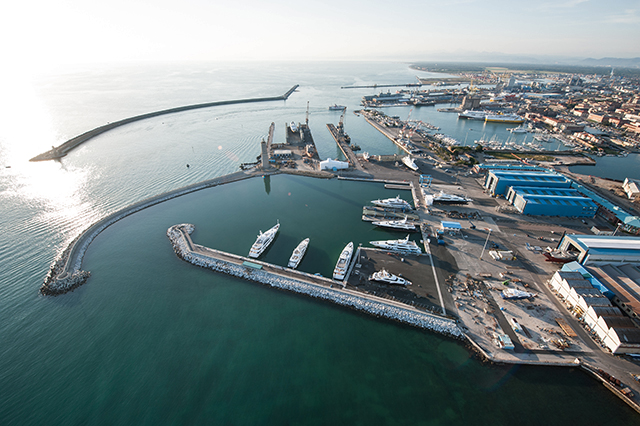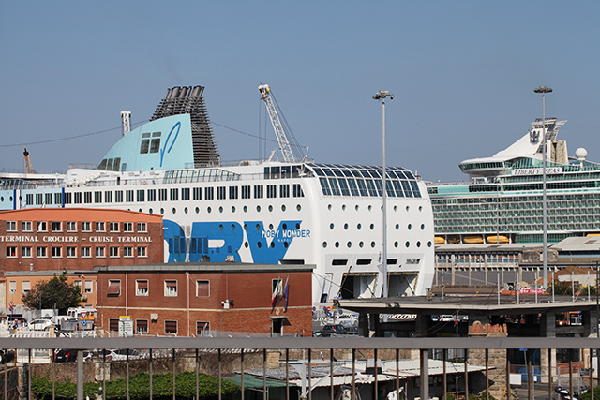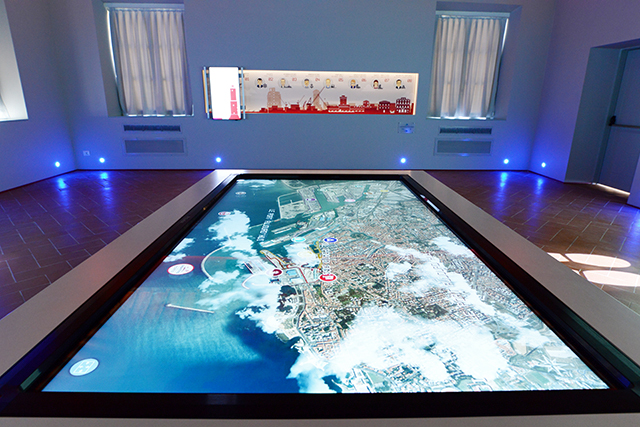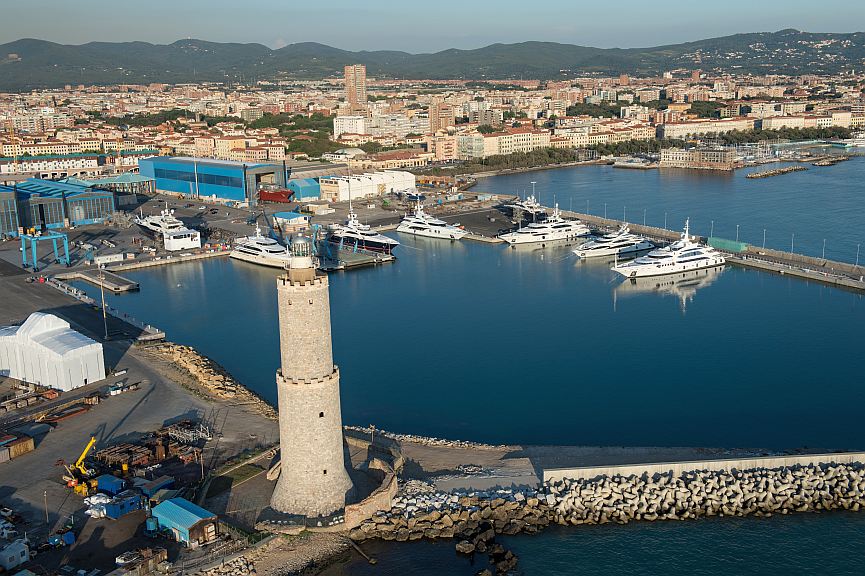The Port and the City of Livorno are elaborating joint solutions to better cope with Covid-19 and support local economy. On the cultural aspect, the Port is doing everything to conserve its link with the citizens: all the activities of the Port Center of Livorno have been uploaded on their website, and abundant “City Port” content is available online, to enjoy from home during the quarantine.
The Port of Livorno is an active member of AIVP since 2000
AIVP – In the context of Covid-19 pandemic, Italy is the most affected European country. What are the consequences of the virus on the port activities, especially on the logistical and economical dimensions?

 Francesca Morucci, Head of Public Relations Office, Port of Livorno
Francesca Morucci, Head of Public Relations Office, Port of Livorno
Massimiliano Barbera, Livorno Port Center
The Covid-19 pandemic crisis is affecting the global economy: UNCTAD says the slowdown will cost at least $ 1 trillion.
As regards the trend of the Italian economy following the Covid-19 epidemic, the contraction forecasted in 2020 in the turnover of Italian companies is between -7% and -18%, which means, in the worst hypothesis around 470 billion euros. The most affected sector will be Tourism: based on the latest news, UNWTO estimates international tourist arrivals all over the world could decline by 20% to 30% in 2020 with an incredible loss of money. But other sectors would be hit by the Covid-19 epidemy: Air Transport, Automotive industry and Transport and Logistics sector would undoubtedly lose their position in the global market.
As regards the port sector, container traffic is expected to remain above 2019 volumes in the first quarter of 2020, but a fall is estimated starting from March. So far Livorno for this traffic has around 7% drop in the first three months. Port Ro/Ro traffic too will be severely hit by the halt to MOS services between Med countries whereas the food supply chain and the medical one are performing well. The most critical situation recorded for commercial traffic is for the new car sector due to the failure of dealers to collect their cars (sales collapse) and therefore overcrowding of storage areas near the quays is occurring.
All the terminals have reorganized their work. For example, in container terminals shifts have been reduced from 6 hours to 5 1/2 hours in order to allow for the sanitization of vehicles and equipment used by workers before each shift change.

One positive point is that manufacturing companies’ warehouses currently closed will remain open to facilitate deliveries and the transportation of goods. This novelty is to be found in President Conte’s latest Prime Ministerial Decree, stating that for suspended manufacturing activities it is now possible to send merchandise stockpiled in warehouses to third parties as well as to receive goods and supplies at warehouses, as long as the Prefect has been previously informed. For Confetra (the Italian General Confederation of Transport and Logistics) this news comes as a breath of fresh air for the sector and the solution to the problem of the growing congestion at logistics centres and transit infrastructure hubs.
But it’s the cruise and ferry activity which is suffering most for the current restrictions: the situation for passenger vessels is continuously worsening following the cancellation of all cruise ship calls and the suspension of ferries ordered by the Ministry at a time when departures are normally intensified. The major Cruise Shipping Companies temporarily shut down operations in March and opted for a lay-up solution, that means a stop in a port with a proper crew onboard maintaining the vessel. At the moment, in Italy 10 ships are moored in lay-up in 8 ports (Savona, Genova, La Spezia, Piombino, Napoli, Civitavecchia, Ancona and Brindisi).

In line with Italian recent directives, all ferries have been suspended till 3rd May, with the exception of pre-authorised services between the Italian peninsula and the major Italian islands (Sardinia and Sicily) but also services to maintain the territorial continuity from Piombino to Elba Island, for instance.
The halt to cruise ships has a direct impact on the whole cruise line value chain, from port terminals to ship construction and repairs, ship chandlers, tour and transport operators, tourist guides, leisure attractions, restaurants and shops. According to Francesco Di Cesare, president of the Italian consultancy firm Risposte e Turismo, 2020 will close in red for the cruise sector, and its full recovery is not likely to be achieved in 2021, but only in 2022. As regards ferries, the scenario could be different, due to the recovery of domestic tourism. Anyway, although it is too early to know the timing of the recovery of the passengers’ activity and also to estimate the real figures related to the impact of the sector stop in the ports of the North Tyrrhenian Network, the cost paid by Tuscany will certainly be high, considering the valuable contribution of cruise and ferry activities to the local economy.
AIVP – We recently read in the press that a City Port crisis table was created, led by Mayor Luca Salvetti, President Stefano Corsini and General Secretary Massimo Provinciali. Can you give us more details about this initiative?
Francesca Morucci, Head of Public Relations Office, Port of Livorno
Massimiliano Barbera, Livorno Port Center
The Mayor Luca Salvetti and the councillor for port affairs, Barbara Bonciani, organized a meeting with the President and the Managing Director of the North Tyrrhenian Port Network Authority – Stefano Corsini and Massimo Provincial –, the Managing Director of the Local Chamber of Commerce Pierluigi Giuntoli, and the CEO of the company managing the cruise/passenger terminal Porto di Livorno 2000, Matteo Savelli. The purpose of the meeting was to take stock of the Covid-19 emergency scenario, in particular, in relation to the cruise/passenger terminal.
From the point of view of social stability, the Salary Integration Fund has been applied to all the staff of Porto Livorno 2000. In order to support the company, the North Tyrrhenian Port Network Authority has taken action at ministerial level with the Ministry of Infrastructure and Transport to promote the extension of art. 92 of the Cura Italia Decree also to passenger terminals (concessionaires ex. Art. 36 of the Navigation Code), in the form it will take when converted into law.
According to the Municipality, the terminal crisis affects not only the port but also the city and the cruise line value chain. This is why it’s important, starting from this meeting, to design the next steps the local bodies will take to support both the company and the workers at this time.
Furthermore, the Municipality and the Chamber of Commerce suggested that the Port Authority use this period of passenger traffic suspension to issue the necessary procedures for implementing the new Passenger Facility project and they offered their support.
The Municipality has also set up an inter-sectoral work group to support the Port Network Authority in developing the Implementation Plan. The first meetings had already taken place just before the beginning of the Covid-19 emergency.
The Mayor, Luca Salvetti, reiterating the importance of the work group on the cruise sector, stressed the Municipality’s commitment to open a comprehensive discussion on the actions to be taken to support businesses and workers in the supply chain. He then reminded everyone of the commitment of his administration to assisting the port in setting up a Covid-19 Emergency Control Room in collaboration with North Tyrrhenian Port Network and the Harbour Master’s Office. As far as the crisis in the cruise sector is concerned, the administration emphasized its willingness, together with the Chamber of Commerce, to open a dialogue with the various sector groups and stakeholders.
AIVP – As an active member of the AIVP Port Center Network, Port of Livorno recently launched a virtual tour of the port, and an interactive platform to discover today’s port activity and jobs. Could you explain us, in few words, this initiative, or other actions you may have launched to keep the link with the citizens and to maintain the access to Port City culture?
Francesca Morucci, Head of Public Relations Office, Port of Livorno
Massimiliano Barbera, Livorno Port Center
As a center for the spread of maritime port culture, Livorno Port Center continues working in the backstage. The suspension of the “social” activities – visits to the multmedia lab, conferences (I giovedì del Port Center – “Thursdays at the Port Center”), visit to the ports of the North Tyrrhenian Network – does not stop the interaction and the communication with the people involved in the project. The virtual tour of the multimedia lab lets visitors discover all this and much more, by way of extensive video-photographic documentation together with descriptive texts: all the contents presented through interactive devices in the physical Port Center are replicated so that the virtual visitor can get a taste of what the real Port Center experience is. What is completely available is the information set regarding port activities and jobs.

Moreover, we are enrichening the section News and Events of the official website and the Facebook page (Livorno Port Center) by posting updated articles regarding what ports and Port Associations are doing during this crisis period. In fact, the contacts with national and international Port Associations are intensifying, producing a grand exchange of views and information regarding the crisis and the measures to tackle its economic impact in the port sector.





